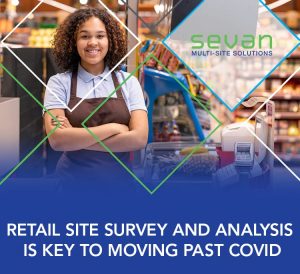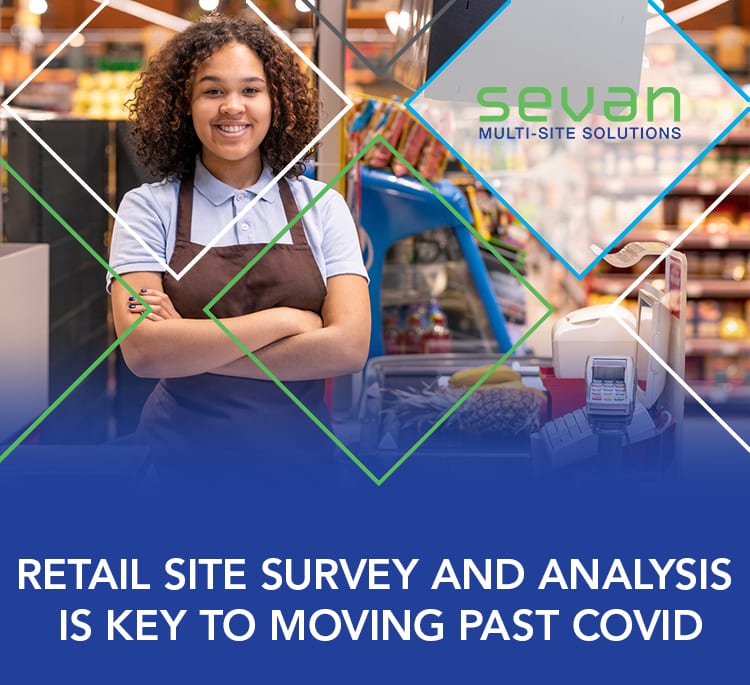Written by Nick Jonihakis, AIA, NCARB, LEED Green Associate, Operations Director at Sevan

Easing into “the new norm,” all 50 states in the U.S. have slowly begun a phased reopening, following the Coronavirus lockdown that began in March.
In doing so, it has become apparent how important it is for store management and owners to understand what physical changes local management of facilities and stores may have made in order to protect their staff and customers amidst Coronavirus concerns and in an effort to abide by CDC recommendations for social distancing. Barriers, way-direction signage, and sometimes even short or full walls have been installed in a reactionary manner in order to best manage travel paths and enable social distancing.
Surveys Collect Data to Understand Store Updates Made Across Your Portfolio
Since the health, safety, and welfare of store and facility team members as well as customers is at stake, it is important to note that many on-site adaptations and additional protection installed on the fly have made a large number of stores non-compliant in relation to functionality and sometimes accessibility guidelines.
As owners get back into the swing of things and have time to sort through the chaos, it is important to clearly document existing spaces and their current conditions, in order to best decide how to revise or even drastically change the current routes and functionality within stores’ spaces.
Here’s why: COVID-19 has radically altered the shopping and buying behaviors of the public during the pandemic, and many of these “new norm” behaviors are expected to continue. A potentially longer-lasting change is the accelerated adoption of the e-commerce platforms being used and the adaptation of new e-commerce platforms being introduced to the American and worldwide public.
These new behaviors are expected to redefine the role of the “brick and mortar” store and will force retailers and all store operators to offer unique experiences—instead of the typical transactional processes in place prior to the pandemic—to drive ongoing customer satisfaction. Contemplated changes must be reviewed and approved, and that cannot be done without first gaining a clear understanding of the physical stores’ current condition including all temporary COVID-19 related alterations.
How Socially Distant Facility Surveys Can Help
In order to be in the best possible position to make decisions about changes to a store’s functional layout, it is necessary to know what updates have taken place as a result of COVID-19. A clear and concise understanding of the existing as-built conditions within stores is of paramount importance. Facility survey technologies available today — such as integrated field investigation reports, 360° spherical photo surveys, and 360° Interactive (LiDAR Scanning) “Digital Twins” — require reduced personnel presence and allow survey companies to conduct surveys using minimally intrusive methods not previously possible.
Surveys are currently performed utilizing CDC-specific guidelines so as to minimize the spread of Coronavirus and maximize social distancing. Multiple survey methods are available with each delivering different levels of information:
- Integrated field investigation reports are customizable questionnaires which collect specific site data and associated photography via a highly configurable mobile app. These survey questions allow for easy determination of what is owned and how it is being used. Such surveys can provide site and asset conditions and information for both fixed and non-fixed assets. The collected information can be shared, organized, and queried as necessary to assist in capital expenditure and repair and maintenance planning.
- 360° spherical photo surveys provide a visual representation of current conditions and allow multiple stakeholders to experience an immersive view of the interior or exterior of a site without the expense of travel or risk of exposure during the ongoing pandemic.
- 360° Interactive “Digital Twins” allow for a complete and total immersive experience of sites, which allows multiple stakeholders to remotely markup details, tag and provide notes, measurements, specifications, documents, photos or weblinks for enhanced site information.
These methods help gather survey data that can be instrumental in property improvements, sell-offs, and transfers and acquisitions, as well as insurance claims stemming from the ongoing pandemic. Prior to an acquisition decision, stakeholders would be best served by procuring these types of services to validate current site conditions and perform due diligence.
Make Your Spaces Ready for the “New Norm,” Nationwide

The post-Coronavirus “new norm” is evolving and is pointing toward coming unprecedented changes in the design and function of public spaces. With good information in hand, companies trying to bounce back can make sound decisions to keep their organizations moving forward in a safe and wise manner.
Regardless of industry, a thorough assessment of current sites and spaces must be a part of these decisions in order to formulate a sound strategy to keep staff and public healthy and confidently returning to work.
Looking for more content surrounding the industry and other similar topics?
